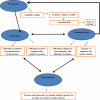A framework for the specificity of addictions
- PMID: 21909314
- PMCID: PMC3166750
- DOI: 10.3390/ijerph8083399
A framework for the specificity of addictions
Abstract
Research over the last two decades suggests that a wide range of substance and behavioral addictions may serve similar functions. Yet, co-occurrence of addictions has only been reported among a minority of addicts. "Addiction specificity" pertains to a phenomenon in which one pattern of addictive behaviors may be acquired whereas another is not. This paper presents the PACE model as a framework which might help explain addiction specificity. Pragmatics, attraction, communication, and expectation (PACE) variables are described, which may help give some direction to future research needs in this arena.
Keywords: PACE model; addiction specificity.
Similar articles
-
Impulsivity and history of behavioral addictions are associated with drug use in adolescents.Addict Behav. 2017 Nov;74:41-47. doi: 10.1016/j.addbeh.2017.05.021. Epub 2017 May 24. Addict Behav. 2017. PMID: 28570913 Free PMC article.
-
The Shorter PROMIS Questionnaire and the Internet Addiction Scale in the assessment of multiple addictions in a high-school population: prevalence and related disability.CNS Spectr. 2006 Dec;11(12):966-74. doi: 10.1017/s1092852900015157. CNS Spectr. 2006. PMID: 17146410
-
Natural course of behavioral addictions: a 5-year longitudinal study.BMC Psychiatry. 2015 Jan 22;15:4. doi: 10.1186/s12888-015-0383-3. BMC Psychiatry. 2015. PMID: 25608605 Free PMC article.
-
Obesity and its relationship to addictions: is overeating a form of addictive behavior?Am J Addict. 2009 Nov-Dec;18(6):439-51. doi: 10.3109/10550490903205579. Am J Addict. 2009. PMID: 19874165 Free PMC article. Review.
-
The need for a behavioural analysis of behavioural addictions.Clin Psychol Rev. 2017 Mar;52:69-76. doi: 10.1016/j.cpr.2016.11.010. Epub 2016 Dec 2. Clin Psychol Rev. 2017. PMID: 28013082 Review.
Cited by
-
Commonalities and Differences Across Substance Use Disorders: Phenomenological and Epidemiological Aspects.Alcohol Clin Exp Res. 2015 Oct;39(10):1878-900. doi: 10.1111/acer.12838. Epub 2015 Sep 1. Alcohol Clin Exp Res. 2015. PMID: 26332166 Free PMC article. Review.
-
Online social networking and addiction--a review of the psychological literature.Int J Environ Res Public Health. 2011 Sep;8(9):3528-52. doi: 10.3390/ijerph8093528. Epub 2011 Aug 29. Int J Environ Res Public Health. 2011. PMID: 22016701 Free PMC article. Review.
-
Generational association studies of dopaminergic genes in reward deficiency syndrome (RDS) subjects: selecting appropriate phenotypes for reward dependence behaviors.Int J Environ Res Public Health. 2011 Dec;8(12):4425-59. doi: 10.3390/ijerph8124425. Epub 2011 Nov 29. Int J Environ Res Public Health. 2011. PMID: 22408582 Free PMC article.
-
Theoretical conceptualisations of problematic exercise in psychometric assessment instruments: A systematic review.J Behav Addict. 2021 Apr 2;10(1):4-20. doi: 10.1556/2006.2021.00019. J Behav Addict. 2021. PMID: 33822749 Free PMC article.
-
Frequent exercise: A healthy habit or a behavioral addiction?Chronic Dis Transl Med. 2016 Dec 20;2(4):235-240. doi: 10.1016/j.cdtm.2016.11.014. eCollection 2016 Dec. Chronic Dis Transl Med. 2016. PMID: 29063048 Free PMC article. Review.
References
-
- Goodman A. Addiction: Definition and implications. Br. J. Addict. 1990;85:1403–1408. - PubMed
-
- Goodman A. Neurobiology of addiction: An integrative review. Biochem. Pharmacol. 2008;75:266–322. - PubMed
-
- Hatterer LJ. The addictive process. Psychiatr. Q. 1982;54:149–156. - PubMed
-
- Jacobs DF. A general theory of addictions: A new theoretical model. J. Gambl. Behav. 1986;2:15–31.
Publication types
MeSH terms
Grants and funding
LinkOut - more resources
Full Text Sources
Medical


